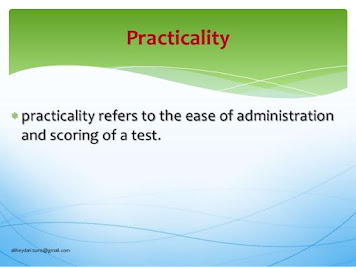According
to Rehman (2007), Usability or practicality is another important characteristic
of a good test. It deals with all practical considerations that go into the decision to use a particular test. While constructing or selecting a test,
practical considerations must be taken into account. Rehman (2007) has given
the following five practical considerations of a test.
Ease
of administration
The test should be easy to administer so that the tester may easily administer it. For
this purpose, it should be simple and contain clear instructions. There
should be a small number of subsets and an appropriate (not too long) time for
administering the test.
Time
required for administration
To provide an appropriate time to take the test, if the time is reduced,
then the reliability of the test will also be reduced. A safe procedure to allocate as
much time as the test requires for providing reliable and valid results.
Between 20 to 60 minutes is a fairly good time for each individual score yielded
by a published test.
Ease
of interpretation and application
Another
important aspect of the practicality of test scores is the interpretation and
application of test results. If they are misinterpreted that will be harmful
to the students. On the other hand, if they are misapplied or not applied at
all, then the test is useless.
Availability
of equivalent forms
Equivalent
forms tests help to verify the test scores. Retesting at the same time on the
same domain of learning eliminates the factor of memory among the
students. The availability of equivalent
forms of the test should be taken into mind while constructing/selecting a
test.
Cost
of testing
A test should be economical in terms of preparation, administration, and scoring.
Importance
of the practicality of a test
The
teachers, particularly untrained teachers can easily administer the tests which
have been constructed/ considering practicality. The parents can be informed
of the right test results if the practical considerations have been taken care of while constructing a test, which they will use in decision-making about their
children. Economical tests may save unnecessary expenses on stationery, print
materials, photocopies, and so on. True interpretations of test scores will be
used by the students in their own plans and decisions (Linn & Gronlund,
2000).
Limitations
• There are chances of giving wrong
directions to students by untrained teachers while constructing or
administering the tests.
•
If time is reduced for taking the test, the reliability of the test is reduced.
•
Chances of misinterpretation and incorrect
scoring in the absence of uniform criteria.
•
Cost of testing is sometimes
given far more weight than it deserves. Tests are relatively inexpensive and
cost may not be a major consideration (Swain et al, 2000).
References:
Linn, R. L., &Gronlund, N.E. (2000).
Measurement and assessment in teaching (8thed.). Delhi:
Pearson Education.
Rehman, A. (2007). Development and validation of objective test items analysis in the
subject physics for class IX in
Rawalpindi city. Retrieved May 12, 2009, from International Islamic University, Department of
Education Web site:
Swain,
S. K., Pradhan, C., &Khotoi, S. P. K. (2000). Educational measurement:
Statistics and guidance.
Ludhiana: Kalyani.
Note:
Plz must visit my other Apps & Tech Websites for more information below here.
My Other Tech Websites
2: Apkroot.net





1 Comments
Excellent post and wonderful blog, this sort of interesting posts I really like, keep it up... Design Sprint Tool
ReplyDeletePost a Comment